Does your sales process seem inefficient, outdated, or like it’s just not working anymore?
If that’s you, don’t worry. The sales landscape keeps changing rapidly. It’s challenging to keep up with new consumer demands and disruptive global events.
We’re here to help you devise a sales strategy that will make sales easier for you in the long run.
A sales strategy puts more purpose behind your sales process. It gives you more ways to test and refine your tactics and make sure you’re providing your sales team and your customers the best possible experience.
In this guide, we’ll walk you through what a sales strategy is, how to use them, and how to develop your own.
And we’ll give you the inside scoop on how a platform like monday.com can help you manage that sales strategy with ease.
What is a sales strategy?
A sales strategy outlines how your business will sell its products.
It uniquely positions your company among its competitors, while also establishing processes and best practices for your sales team to follow.
Now you could throw a handful of sales tactics to the wall and see what sticks. But, with a little research and planning, you can craft a targeted strategy that meets your audience’s needs.
A sales strategy can encompass a lot of different tactics. Or you might develop a different sales strategy to support different products or audiences.
For instance, audience segmentation is a sales strategy you probably already use, considering 97% of marketers say they leverage it. But segmenting your prospects isn’t a complete sales strategy. It’s just one piece of the puzzle.
No 2 sales strategies will be exactly the same, but there are some common tactics or elements that many sales teams leverage.
You might craft a detailed sales pipeline, collaborate with the marketing team, or use a CRM or similar tool like this one from monday.com to track your progress.
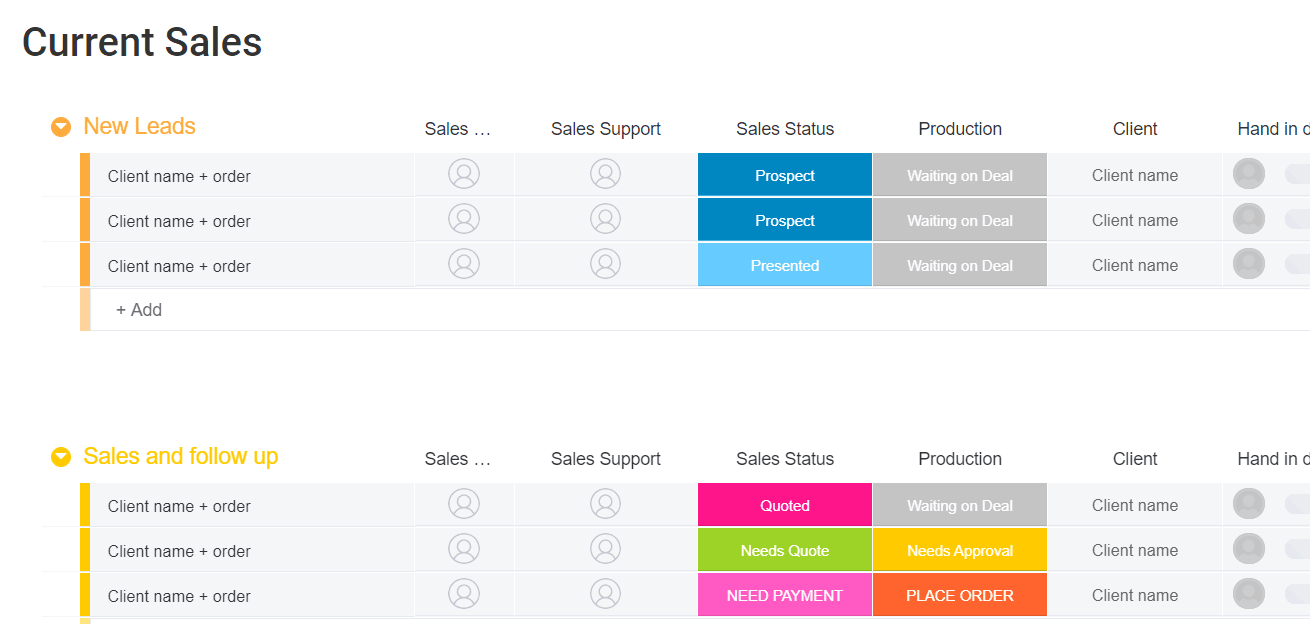
We’ll talk about all of these sales strategies and more later. But first, let’s look a little closer at the different types of sales and how their strategies differ.
Inbound sales vs. outbound sales
When it comes to sales strategies, there are 2 main types: inbound sales and outbound sales.
An inbound sales strategy focuses on the consumer. It’s a personalized process that nurtures leads by offering content, deals, and more.
An outbound sales strategy focuses on the salesperson. It’s a lot less personalized, which allows sellers to contact more prospects more quickly. Cold calling and emailing are popular outbound sales tactics.
While it might sound like inbound sales is clearly superior — especially considering 44% of consumers would switch to a brand that offers a more personalized experience — both inbound and outbound sales have their uses in a holistic sales strategy.
It’s true that inbound sales meet current consumer demands. But outbound sales are easier to scale and can require fewer resources per conversion.
Plus, 48% of marketers say email is a highly effective tactic for driving conversions, especially in a B2B sales strategy.
In all likelihood, you’ll want a mix of inbound and outbound tactics incorporated into your final sales plan. You can read more about the different type of sales here.
Now, let’s look at the steps you’ll take as you develop your sales strategy.
5 steps to developing your sales strategy
Before we dive into the specific steps in creating a sales strategy, it’s important to remember that your sales strategy needs to be tailored to your company’s unique audience, products, and value proposition.
These steps will provide the framework, but you’ll need to dig deep into what’s unique about your business to create a sales strategy that works best for you.
1.Set sales goals and quotas
The first step is figuring out exactly what you want your sales strategy to achieve. Once you know where you’re going, you can figure out the path to get there.
You can think of your sales goals in 2 different ways:
- Inputs: quotas based on the sales team’s actions, such as emails sent or prospects added.
- Outputs: goals based on the sales team’s results, such as sales made or contracts signed.
You’ll likely want a couple of goals in each category, but be sure to stay focused on what’s relevant to your business. Your goals are meant to help you focus your efforts as a sales leader on getting the results you want, not clutter up your mind with unnecessary information.
To track your sales goals, consider creating a dashboard like this one in your CRM tool.
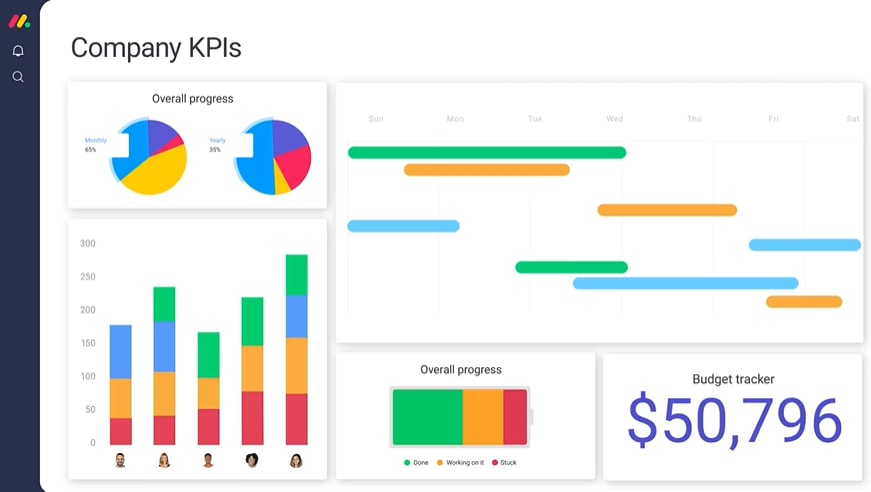
You’ll be able to keep an eye on sales performance at all times. And 51% of companies use data like this to assess sales rep performance, so it’s an easy way to accomplish several things.
2.Research customers and competitors
Once you’ve set your sales goals, it’s time to learn everything you can about both your ideal customer and your existing competitors.
First, understand your target market’s demographics — things like age, gender, or income level. Then, figure out their pain points. What problems is your ideal customer trying to solve?
With this information, you can develop a buyer persona or ideal customer profile to use as a reference for future sales strategies.
Next, learn how your competitors are addressing these pain points, and see what you can offer that makes you a better choice than a competitor.
Keep in mind that personalization is very important for many customers today, so another benefit of this research is to help you demonstrate your understanding of your audience’s needs.
Leverage customer data into personalized campaigns, such as recommending products or improving customer service like 46% of marketers do.
3.Identify your unique value proposition
Using your target marketing and competitor research, think about what truly sets you apart from the competition.
This is your unique value proposition — something that only you can offer a certain group of consumers. This will be the cornerstone of your sales strategy.
A unique value proposition allows you to tailor your sales strategy to exactly how your product benefits your specific audience.
4.Create a sales pipeline
Now that you have all of this information, it’s time to start putting together a sales pipeline.
This is a series of stages a prospect will go through before they become a customer. The exact stages and actions depend on whether you’re using inbound or outbound sales tactics, as well as whether you’re in B2C sales or B2B sales.
No matter which specific tactics you use, the sales pipeline stages often include prospecting, lead nurturing, a product demo or trial, and finalizing the sale.
You can monitor your entire sales pipeline in a lead tracking software or other sales template, like this one in monday.com.
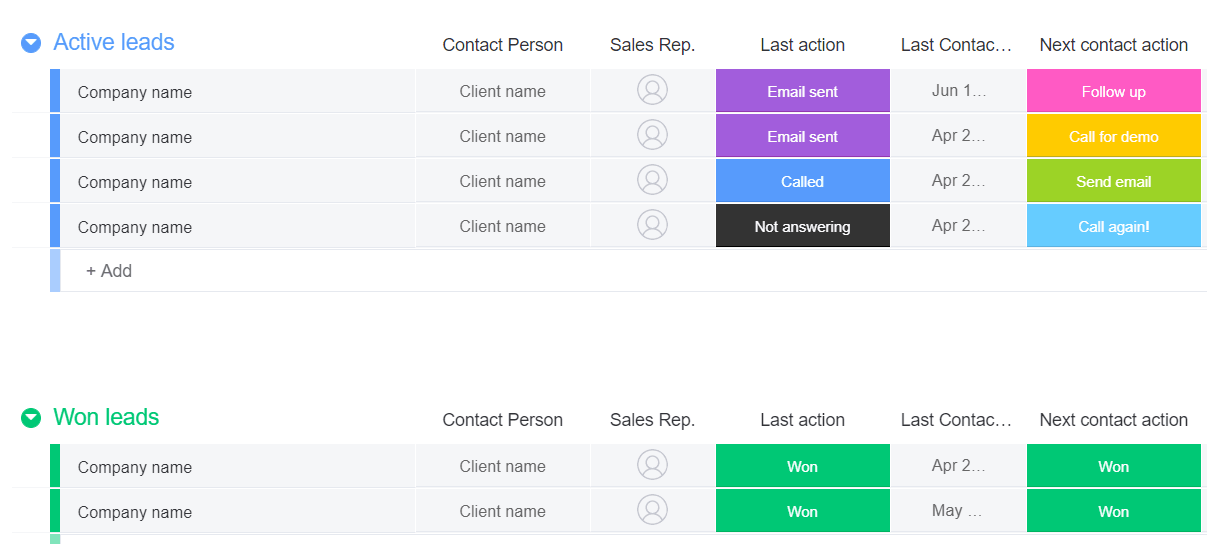
Once you have this basic framework, you can use it to test different sales strategies. For instance, you might test sending follow-up emails at different intervals to see which has the best response rate. Or you can test whether cold calling or cold emailing is more effective.
5.Test and refine as needed
Consumer demands change, new competitors crop up, and sometimes strategies just get stale. That means your sales strategy will likely evolve and change over time.
It’s important to check in regularly to see what’s working for your sales team and what’s not. You can use dashboards or build other sales tools in monday.com to help you keep an eye on performance.
By regularly checking in and refining your process, you’ll be better positioned to handle unexpected changes. And since 70% of sales managers say navigating change is a much more important skill than it was 5 years ago, it’s a worthwhile investment of your time.
3 sales strategy examples
There are dozens of ways to create a successful sales strategy, and sales teams are constantly devising new ways to connect with their target market.
But to help you understand how to approach creating your own sales strategy, we’ve come up with a few examples that you can adapt for your own strategic sales plan.
Create an automated follow-up sequence
Follow-ups are highly effective at turning leads into sales, but — if you have a high volume of potential customers — it can quickly become an overwhelming tactic.
With automation, however, follow-ups become a lot easier to scale. Even better, you can optimize your follow-up sequence, scale your data, and so much more.
It’s no wonder 43% of salespeople say they’re frustrated by a lack of automation. It makes their job so much easier!
You can use automation tools in your CRM or email marketing tool to follow up with prospects at predetermined intervals.
monday.com has automation recipes for exactly this kind of task — and a lot more. It also integrates with MailChimp and other tools to help you work more effectively.
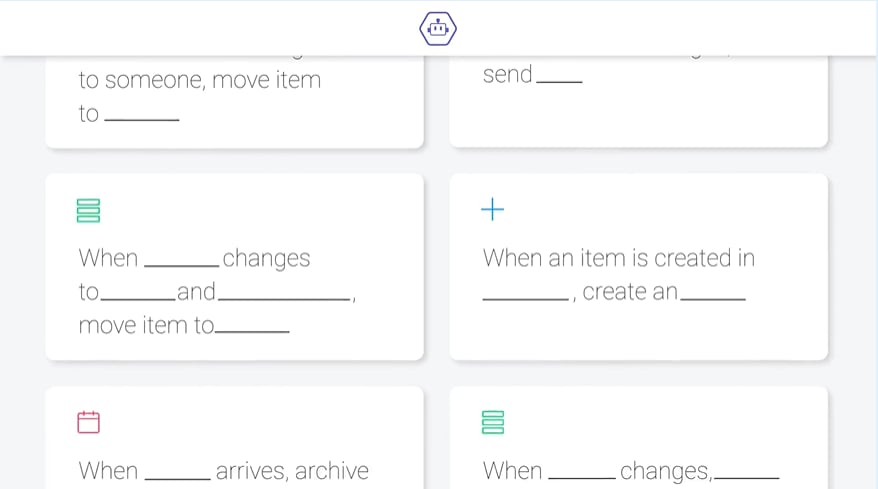
In your follow-up emails, you can offer educational content, exclusive deals, or a chance to ask any questions they might have. The sequence should align with your sales process as closely as possible. And don’t be afraid to make changes if something isn’t working.
Position sales reps as subject matter experts
Customers want to buy from authoritative salespeople. 40% of consumers say they want their salesperson to be an expert in the field, and 88% of buyers consider their sales reps “trusted advisors.”
Gain a competitive advantage from this trend by creating expert content and training sales reps on all the latest trends in your industry. In this way, you’ll help your sales team operate as consultants, not just cold callers.
Casting your sales reps as subject matter experts goes a long way toward building trust among customers. Establishing the brand as an authority can have far-reaching impacts on SEO, social media following, and word-of-mouth marketing.Develop a lead scoring system
In a lead scoring system, prospects are assigned points based on certain actions, like opening emails, clicking links, or filling out an online form.
When a prospect has passed a certain threshold, they are considered “qualified” — or, in other words, engaged and interested enough in the product to be likely to make a purchase.
With a lead scoring system, you’ll focus on prospects that are more likely to result in a sale. It’s reported that 34% of sales reps meet very frequently with unqualified buyers, wasting time and slowing down revenue creation. A lead scoring system immediately helps reduce that waste.
Lead scoring often helps sales and marketing teams work more closely. 94% of top-performing salespeople say marketing-qualified leads are excellent or good, thanks to the data they can access and share.
With a lead tracking template in monday.com, you can monitor the qualified status of each prospect. It’s shown below in the “Heat” column.
![]()
Marketing and sales can access the same dashboard to learn if a lead is qualified, streamlining your sales process even further.
Execute your sales strategy with monday.com
monday.com is a Work OS that operates as a single source of truth not just for sales leaders and teams, but for marketing and support teams, too.
Your sales organization can use monday.com as a CRM, tracking every piece of your sales funnel. You can integrate old CRMs or other tools to truly keep everything in one place.
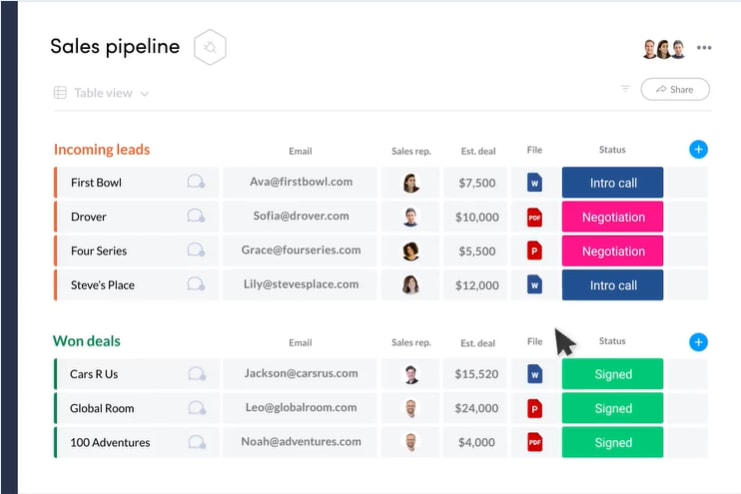
monday.com also has plenty of features for collaborating both internally, and through integrated tools like Slack or Zoom. You can also create workflow automations to streamline processes across your business.
No matter what your company needs, you can build it in monday.com.
Start managing your sales strategy the right way
An effective sales strategy focuses your efforts and helps you, as a sales manager, boost efficiency and productivity on your team.
To develop and manage your sales strategy, it’s important to have a CRM and other sales tools to stay on track. You can build all of these tools and more in monday.com.

